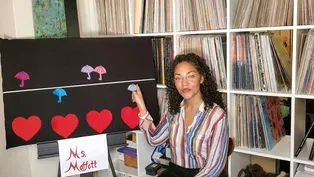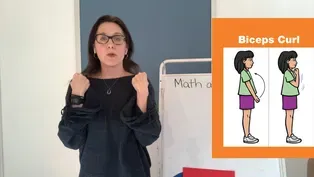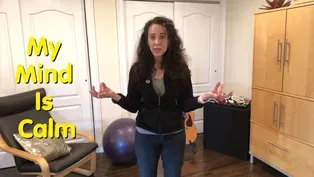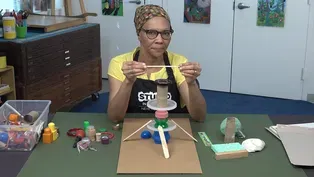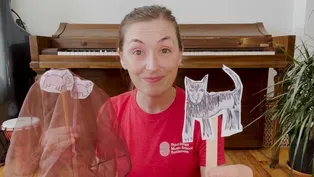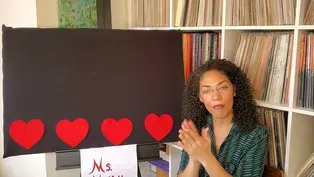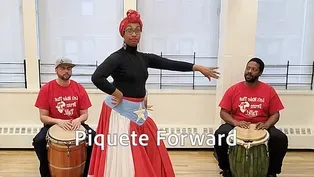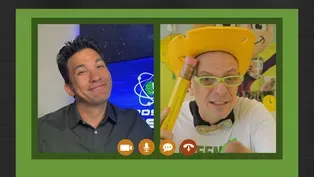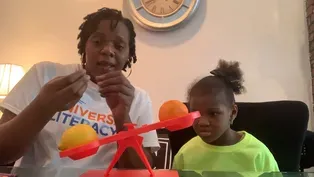
Speak and Green Both Have Long “e”!
4/13/2021 | 56m 46sVideo has Closed Captions
Meet dinosaurs, explore melodies, read GREEN IS A CHILI PEPPER, practice long e.
Meet dinosaurs, explore melodies, read GREEN IS A CHILI PEPPER, practice the long e sound. LET’S LEARN helps children ages 3-8 with at-home learning. One-hour programs feature instruction by educators and virtual field trips.
Problems with Closed Captions? Closed Captioning Feedback
Problems with Closed Captions? Closed Captioning Feedback
Let's Learn is a local public television program presented by THIRTEEN PBS

Speak and Green Both Have Long “e”!
4/13/2021 | 56m 46sVideo has Closed Captions
Meet dinosaurs, explore melodies, read GREEN IS A CHILI PEPPER, practice the long e sound. LET’S LEARN helps children ages 3-8 with at-home learning. One-hour programs feature instruction by educators and virtual field trips.
Problems with Closed Captions? Closed Captioning Feedback
How to Watch Let's Learn
Let's Learn is available to stream on pbs.org and the free PBS App, available on iPhone, Apple TV, Android TV, Android smartphones, Amazon Fire TV, Amazon Fire Tablet, Roku, Samsung Smart TV, and Vizio.
Providing Support for PBS.org
Learn Moreabout PBS online sponsorshipMore from This Collection
Video has Closed Captions
Read SCHOOL BUS and draw one, learn about prefixes and pitch, build sculptures. (57m 48s)
Running and Counting Both End in “ing”!
Video has Closed Captions
Move to improve, find the missing number, learn songs from Ghana, read ABUELITA’S SECRET. (58m 17s)
What Sound Does “aw” Make in Draw?
Video has Closed Captions
Read a story, discover "au" and "aw," learn about density, count, and move with music. (56m 58s)
Can You Find the Short “u” in Subtract?
Video has Closed Captions
Help Super Grover 2.0 solve a prickly problem, read ALL THE WAYS TO BE SMART. (56m 19s)
What Sound Does “gl” Make in Glove?
Video has Closed Captions
Play the glockenspiel, help Super Grover 2.0 make a cart move, read TWO WOOL GLOVES. (58m 9s)
Incredible Starts with Short “i”!
Video has Closed Captions
Solve problems with Super Grover 2.0, catch a rainbow, hear a piano sound like a cuckoo. (56m 9s)
What’s the Sound of “oo” in Book?
Video has Closed Captions
Explore animals’ form and function, sing about the 3 little pigs, read THE LITTLE BOX. (58m 15s)
We’re Reducing, Reusing and Recycling!
Video has Closed Captions
Learn all about rhythm and the number 9, read A BAG IN THE WIND. (56m 17s)
Video has Closed Captions
Learn to dance bomba and grow food in a city, read WOLF CUB’S SONG. (55m 20s)
How Many Syllables are in Invent?
Video has Closed Captions
Invent your own instrument, make 10 to add numbers to 20, read ONE GOLDEN RULE AT SCHOOL. (57m 36s)
Video has Closed Captions
Learn about the science behind mind reading, count shells, read MY BIG FAMILY. (57m 27s)
Which is Heavier: One Apple or Two Apples?
Video has Closed Captions
Defy gravity, learn secret code words for fast and slow in music, read WHOOO KNEW? (58m 5s)
Providing Support for PBS.org
Learn Moreabout PBS online sponsorship[playful music] - [Narrator] Ready to learn?
- Hi!
- Hi!
- [Narrator] It's time to share a story.
Read and write.
- Let's read it back.
- [Narrator] Discover science, sing.
♪ Somewhere ♪ - [Narrator] Play and so much more.
- Cupcake!
- Very good.
- [Narrator] Stay tuned for lessons and activities.
We're gonna start making some words.
Isn't that fun?
[playful music] - [Narrator] Funding for this program was provided by the JPB Foundation.
[playful music] - Hey, everybody.
My name is Laura - And I'm a teaching artist at New York City Children's Theater.
Today, we're gonna read a book called Green is a Chile Pepper.
A book of colors by Roseanne Greenfield Thong.
Illustrated by John Parra.
Red is a ristra.
Red is a spice.
Red is our salsa on top of rice.
Red, [Spanish word].
Have you guys ever had a salsa on top of rice before?
Don't knock it till you try it.
I think it's delicious.
Red is a ribbon.
Red is a bow and skirts for [speaking in Spanish].
Red, [Spanish word].
[speaking in Spanish] is a Mexican folk dance.
It involves a lot of swirling skirts, heel stomping, and beautiful costumes.
Orange are the marigolds on Day of the Dead.
Orange or the [Spanish word] for special bread.
Orange, [Spanish word] What kind of bread do you guys think this is?
Kind of looks like cinnamon buns but I think it's conchas, which is a Mexican sweet bread.
Yellow is a [Spanish word].
We used to make [speaking in Spanish] and sweet corn cake.
Yellow, [Spanish word].
Yellow are the stars that lighten the night.
Yellow are [Spanish word] flickering bright.
Yellow, [Spanish word].
This is my favorite page, actually.
[Spanish word] means lanterns in Spanish.
I love how the [Spanish word] and the stars work together to light up the night.
Green are the corn stocks, green are the pails.
Green is a bench for abuela's tales.
Green, [Spanish word].
I'm very lucky that I got to sit with my grandma and hear her stories.
If you have someone in your life who's older and wise, maybe you could sit down with them and hear their stories too.
Green is a chili pepper, spicy and hot.
Green is [Spanish word] inside our pot.
Green, [Spanish word].
Blue is the endless sky above and handmade crafts for those I love.
Blue, [Spanish word].
It looks like this kid got distracted from craft making.
He's hanging out with the chicken.
So silly.
Purple are the rides that swirl and spin and the [Spanish word] prizes that we win.
Purple, [Spanish word].
Have you guys ever been on a ride like this?
Or like this?
If you have, you're very brave.
Pink are [Spanish word] and candles that glow.
Pink are [Spanish word].
Watch out below!
Pink, [Spanish word].
Brown is a [Spanish word], warm and sweet.
And homemade chocolate, a special treats.
Brown, [Spanish word].
Wow.
On a scale of one to 10, let's say how much we would love a churro with some homemade chocolate right now.
Ready?
One, two, three, 11.
[chuckles] White are the flowers we put in a vase and sugar skulls and handmade lace.
White, [Spanish word].
White are the doves that chatter and coo and the [Spanish word] for me and you.
White, [Spanish word].
[Spanish word] means popcorn in Spanish.
So now next time that you're watching a movie, you can ask the grownups for some [Spanish word].
The world is a rainbow of wonder and fun.
Ribbons of colors rolled into one.
[speaking in Spanish] and xylophones too.
These beautiful colors are waiting for you.
[sighs] Now you see why I love this book.
The fact that it rhymes also makes it feel like a beautiful long song, right?
It's amazing how different everyone's lives look and this community in Mexico clearly has a very colorful life.
I bet your life is colorful too.
Let's gather some ideas on the colorful world around us.
First, I want you to think of something that's green, but here's the catch.
It also has to be something that grows.
Green, grows.
Let's think about it for a second.
Green and grows.
Got it?
Okay.
Let's share.
Ready?
One, two, three.
Nice.
I thought of a lime.
Okay, now let's come up with something that is both red and in the room you're in now.
Look around, keep looking.
Do you see something red?
Okay, tell me what it is in one, two, three.
Awesome.
I found this.
Great job, everybody.
Finally, let's think of something that is blue that we love.
Anything you love that's the color blue.
Let's think.
Okay.
I've got mine.
Ready?
One, two, three.
Nice.
I thought about the ocean.
[chuckles] It's so fun to think about the colorful world around us.
No matter where you go, color will always play a role in telling the story of our lives.
I had a lot of fun reading this book with you today.
Thank you for joining me and I hope you have a fun colorful day.
Bye.
- Hi, movers and shakers.
This is Violet and I'm here with my sister, Ivy.
- Hi.
- And we have a song for you today that also has a game and it's called the name game.
So we're gonna sing it for you.
Whose name should we use first?
Let's do yours.
Okay.
All right, ready?
♪ Violet, violet, bo Biolet ♪ ♪ Banana fana fo Fiolet ♪ ♪ Me my mo Miolet ♪ ♪ Violet ♪ Did you catch that?
All right, let's try it with your name now.
- All right.
- All right, ready?
♪ Ivy, Ivy bo Bivy ♪ ♪ Banana fana fo Fivy ♪ ♪ Me my mo Mivy ♪ ♪ Ivy ♪ Have you ever heard of this song?
It's a funny one.
And can you share the pattern?
I wonder if you could do it with your own name.
So how it works is you start with your name and if your name doesn't start with a vowel like mine, you replace the first sound with a different sound for each part of the song.
So first we say our name, in my case, Violet.
And then every time after that, we're going to change the first sound, first with a b sound, with a B.
Then with a f sound, an F. And then lastly, a m sound.
M, that's the sound that M makes, right?
M. So Violet, Biolet, Fiolet, Miolet.
And Ivy's name starts with a vowel.
And so, instead of switching the first sound, you just add the first sound in front of it.
So what would your name be then for the sounds?
- So it's Ivy, Bivy, Fivy, Mivy.
- Isn't that silly?
All right, we're gonna sing it once again slowly with each of our names.
And then wanna hear using it with your own name.
All right?
So we're gonna start with violet and we'll do it slowly.
♪ Violet, violet, bo Biolet ♪ ♪ Banana fana fo Fiolet ♪ ♪ Me my mo Miolet ♪ ♪ Violet ♪ Did you hear those sounds?
All right, listen to them.
And we're gonna try it with Ivy's name.
♪ Ivy, Ivy bo Bivy ♪ ♪ Banana fana fo Fivy ♪ ♪ Me my mo Mivy ♪ ♪ Ivy ♪ All right.
Do you think you can do it?
- I think you can.
- Okay.
Let's hear you do it.
Ready?
Great job.
Thanks, everyone.
We'll see you next time.
- See you next time.
[playful music] - Hello, scholars.
Welcome to a wonderful day of learning.
My name is Anna and I am thrilled to work with you.
Today, we will blend words and read words all with a specific focus on the long E sound.
But first, let's wake up those ears of ours.
I'm going to say some sounds, and I want you to blend those sounds together to figure out what the word is.
Listen to me first.
So if I said the sounds b, e, t. Well I would blend those sounds together, b, e, t and I would say the word bet.
All right, how about you try this one?
Listen to these sounds.
B, e, s, t. That's right.
When you blend those sounds together, you get the word best.
Okay, how about these sounds?
P, o, t. Great.
The word is pot.
All right, how about this one?
Listen carefully.
P, o, s, t. That's right.
Don't forget all the sounds in that word.
P, o, s, t is the word post.
All right, how about this word?
L, ie.
Awesome, lie.
How about this word?
F, l, y.
Great.
You weren't fooled by me adding that new sound at the beginning.
The word is fly.
Okay, how about this word?
B, e, d. Awesome.
The word is bed.
All right, how about this word?
B, e, n, d. Terrific.
The word is bend.
All right.
Now I'm really gonna try to trick you.
You're ready for this one?
Listen carefully.
Sh, e, ep.
Oh, that diagraph didn't trick you at all sound.
Okay.
So sh, e, ep becomes sheep.
All right, let's do two more words, right?
How about this word?
L, o, ck.
Great, yes, the word is lock.
Alright, last one.
Listen carefully.
F, l, i, ght.
Great job, the word is fight.
Sound challenge.
See if you can guess the mystery word B. ea, ch.
A little faster.
B, ea, ch.
What's the mystery word?
- [Woman] Beach.
- Are you ready to become word detectives?
All right, cool.
I have a game for us to play.
I'm going to say a sentence.
However, one word, I'm only going to say the sounds too.
It's going to be your job to see if you can crack the code and figure out what the word is so that you understand what the sentence is.
All right.
Let me try one first.
So listen carefully.
The sentence is Dave will wr, ite, a story.
Well, when I blend wr, ite, write.
Write.
Oh, the secret word is write.
Okay, so that means I've cracked the code and the sentence is Dave will write a story.
So cool.
Are you ready to crack the code yourselves?
Okay.
Here's your first sentence.
Brush your t, ee, th every day.
What's the secret word?
That's right.
The secret word is teeth.
All right.
So you've cracked the code now.
What was the full sentence?
Do you remember?
That's right.
Brush your teeth every day.
All right, let's do a couple more of these.
You're doing a great job.
Listen carefully.
Can you b, l, ink your eyes three times?
What's the secret word?
That's right.
The word is blink.
So what was the sentence?
Exactly.
Can you blink your eyes three times?
All right, how about this sentence?
Kailey has a pet f, r, o, g. What's the secret word?
Frog.
So what's the full sentence.
Great.
Kailey has a pet frog.
Okay.
How about this one?
I do not want to t, ou, ch a cactus.
What's the secret word?
That's right.
The secret word, touch.
So what is the sentence?
I do not want to touch a cactus.
All right, let's do one more together.
Ready?
Look both ways before you c, r, o, ss the street.
What's the secret word?
Awesome sauce.
That's right.
The word is cross.
So what is the sentence?
That's right.
Look both ways before you cross the street.
You are awesome word detectives.
Sound challenge.
See if you can guess the mystery word F ee t A little faster.
F, ee, t. What's the mystery word?
- [Woman] Feet.
- As promised, we are going to focus on the ways to spell the long E sound.
Now the long E sound is simply saying its name.
So the long E sound is E. Can you say that after me?
The long E sound is E. E. Perfect.
So there are so many ways to spell that long E sound.
But today, we're only going to focus on two specific ways.
We're going to be looking at the ee spelling and the ea spelling.
With the ee spelling, you'll usually see it in the middle of the word or at the end of the word.
Like feed or the word flee, like to run away.
Woo.
Okay.
Now with ea, you can see it anywhere.
You might see it at the beginning of a word, like eat.
You might see in the middle of the word, like beach or you might see it at the end of the word, like flea.
But this flea is like a bug.
Okay.
So let's do some sound by sound blending with our long E sound.
So let me move this out of our way.
And I'm going to write one of our words.
Notice that ee is going to be making that long E sound.
Everyone say E. Yeah, notice how you smile when you say it?
So remember, I'm gonna keep my diagraph together.
Then we're gonna blend them a little closer.
And then finally, we will say all of our sounds together.
Are you ready?
Okay, let's do this.
Ch, ee, k. Blend a little bit.
Chee, k. Finally, cheek.
Awesome.
Let's do a sound by sound blending activity.
Let's blend and read together.
Take a look at this first line.
Remember, wherever we see ea or ee, we are going to use the E sound which is the long E sound.
Let's blend through the first two words together and then you will do the rest on your own.
Ea, t. Eat.
M, ea, t. Mea, t. Meat.
Notice how eat and meat have similar sounds.
The difference is the m at the beginning of meat.
Keep going.
Awesome.
Let's keep going with another line.
Once again, remember that ea and ee represent the long E sound.
Now it's time for a sentence.
First, identify the E words and then read through the sentence.
Could you find the long E words?
That's right.
See was one of the long E words.
Jeep was another long E word.
And beach was the final long E word.
Let's reread this sentence together.
Did you see the jeep at the beach?
Amazing job scholars.
Scholars, you did an impressive job today.
You were able to blend and read words all with that long E sound spelled ee and ea.
Make sure you keep practicing blending and reading words with a trusted adult.
Well, until next time, scholars.
Be safe, keep learning and have fun.
Bye.
- As a parent, I know I'm my child's first and most important teacher.
So I'm constantly looking for learning opportunities.
What I've discovered is that they're everywhere.
- Five, four, three, two, one, zero.
- Good.
- [Woman] Whether we're at home on the bus or in the park, there's always something I can do to get my little one thinking and learning.
The more my child learns outside of school, the more prepared he'll be for the classroom.
Plus learning together can be really fun.
Children learn best during activities that are part of their everyday routines.
- Four, five, six.
- [Woman] So we practice basic math skills like counting and number recognition all through the day.
- I spy with my little eyes number six.
- [Woman] When we go for walks around the city, I talk with my child about math concepts like sizes, shapes and patterns.
Comparisons are his favorite.
[speaking in foreign language] - At home, laundry is a perfect chance for us to work together on matching and sorting.
Can you help me find the other blue sock?
[lively music] Ah, good job.
When I introduce math to my child early on, I'm giving him a headstart in school and in life.
My little laundry sorter might just be tomorrow's rocket scientist.
[lively music] [playful music] [playful music] - What was that?
Is there a dinosaur in the Bronx?
I've always loved dinosaurs.
When I was a little boy, I love learning about dinosaurs.
I wonder how big did dinosaurs get?
What did dinosaurs eat?
Are there any living today?
Where could you go to see a dinosaur?
[phone ringing] - Hello, Mr. Ritz, it's Patty, the pigeon.
- Wow.
I've never gotten a phone call from a bird before.
- I heard you're looking for some big dinosaurs.
- Word travels fast in this town.
- Well, I was approaching on the American Museum of Natural History the other day and I noticed some really big dinosaurs through the window.
Maybe you could look there.
- That's a great idea, Patty.
Thanks.
- I also noticed the feet and claws of some of the dinosaurs look just like mine.
Do you know why Mr. Ritz?
- That's an excellent question.
Maybe the museum will have some answers, Patty.
I'll call you back later.
Let's investigate.
[playful music] Wait a minute.
My uncle, Dr. Ritz, the paleontologist works at the American Museum of Natural History.
Let's go pay him a visit.
I'll grab my other hat.
Let's go.
Wow, we made it.
Now that's one big dinosaur.
Dr. Ritz told me to meet him at the titanosaur.
I don't see Dr. Ritz here.
I wonder, what dinosaur is this?
[lively music] Oh, this is a barosaurus.
I can't wait to see the titanosaur.
Maybe this way.
[lively music] Wow.
I never knew there were so many things in the museum.
I wonder how are we going to find the titanosaur?
What about a map?
This museum is so big that the museum provides a map.
So every visitor can find what they wanna see.
Let's take a look.
This is a map of the fourth floor.
Do you see the titanosaur on the map?
Hmm, Titanosaur starts with a T. Do you see a word that starts with a T?
Yes, titanosaur.
Let's go meet my uncle.
Dr. Ritz, the paleontologist.
We're on the second floor.
Let's find our way upstairs.
This way, please.
OMG it's so much bigger than I imagined.
I guess that's why they call it a titanosaur.
Do you know what Titanic means?
When we say something is Titanic, we mean it is very, very large.
- Mr. Ritz, Mr. Ritz.
- Why, hello, Dr. Ritz.
It's so good to see you.
- I see you've met my friend.
You know titanosaur were some of the largest land animals to ever roam the earth.
- How long is it?
- This titanosaur is 122 feet long and it was only a teenager.
[speaking in foreign language] - That's incredible.
I remember reading about dinosaurs when we were little.
And I'm still a little scared that it's going to eat me.
- Mr. Ritz, you have nothing to worry about.
Even when this titanosaur was alive, he only ate plants.
- Whew.
Good to know.
I noticed a leaf stuck in his teeth.
Let me get my toothbrush and get that out.
- Thanks, Mr. Ritz.
You know, not all dinosaurs were big like the titanosaur.
Dinosaurs were all different shapes and sizes.
- There were small dinosaurs too?
- There sure were.
Take a look at protoceratops.
These guys grew to about 400 pounds, which sounds like a lot, but that's about the size of a large pig.
- Imagine a barnyard full of protoceratops.
- E-I-E-I-O.
- E-I-E-I-O.
That's funny, but these dinosaurs lived in the wild.
They had special features that help them survive and thrive in the environment that they lived in.
- Environment?
That's a big word, Dr. Ritz.
I wonder how many syllables are in the word?
En, vi, ron, ment.
That's four.
- An environment is all of the living and non-living things in an area.
Plants, animals, air, water, soil, minerals, rocks, and even people.
There are many environments on earth all with different animals, plants in minerals within them.
We all depend on our environment to survive.
- What makes up the environment where you live?
It's sort of like a community.
Hey, Dr. Ritz.
Why were titanosaur's neck so long?
- Well, titanosaurs has had really big bodies and spent lots of time eating plans in their long necks.
Let them stand in one place and eat a lot.
Take a look at its feet, Mr. Ritz.
- Those feet are similar to an elephant's feet.
- Elephants are also very big.
Elephants and titanosaurs both have large bodies.
They need strong, sturdy legs and feet for support.
By the way, Mr. Ritz, I love those green sneakers you have on.
- Why, thank you.
Those shoes would look great on you, but that dinosaur with the long pointy claws might have some trouble putting them on.
You know Dr. Ritz, I wonder why didn't some dinosaurs have three sharp toes.
- Ah, yes.
That's Tyrannosaurus rex, we call them T-Rex.
They had sharp claws and they ate meat.
- Yikes.
- All the better to eat you with.
[laughs] Just kidding.
This T-Rex can't hurt you.
It's eating days are long over how long over.
- How long over?
- T-Rex lived 65 million years ago.
That is a long time.
I wonder why T-Rex teeth looks so different from titanosaur teeth?
- Well, Mr. Ritz, titanosaur teeth are long and shaped like pencils.
Together, act like a rake.
They're great for pulling leaves and tearing branches.
T-Rex teeth are long and sharp and greet from biting through meat.
- So you're telling me we can discover what a dinosaur ate by observing their teeth?
- That's right.
And those are just some of the clues that paleontologists like me, use to study ancient creatures.
- Big word alert.
I think paleontologist may be even longer than environment.
Pal, e, on, to, lo, gist.
Wow, six syllables.
What's a paleontologist, Dr. Ritz?
- A paleontologist is a scientist who studies living things from long, long, long ago.
Often by studying fossils.
- A fossil?
Slow down, Dr. Ritz.
What's a fossil?
- Fossils are remains or traces of ancient life that are usually buried in rocks.
We dig through the earth to find them.
Fossils could be formed through bones, teeth, shells, leaf impressions, nests, or even footprints.
This evidence reveals what our planet was like long, long ago.
Paleontologist use fossils to learn about the history of the earth.
In fact, these dinosaurs are all fossils.
- Whoa.
That is so cool.
Since you're a paleontologist, you study fossils to learn about life a long, long, long, long, long, long, long time ago.
- That's exactly right.
- I wonder, are there any dinosaurs living today?
- Oh, you're gonna love this.
Follow me.
Take a look at these dinosaurs, Mr. Ritz.
- Look how small they are.
- Do you notice anything?
Perhaps in their feet?
- Let's investigate.
Let's observe with our eyes.
What do you see?
Look at those feet, they have three forward fishing toes.
They look like bird feet.
OMG, Dr. Ritz.
Are you telling me their birds are related to dinosaurs?
- Not just related, Mr. Ritz.
Birds are dinosaurs.
Birds are part of a group of dinosaurs called Theropods.
The only ones that are still alive today.
That means all the birds around us, the pigeons in our cities, the seagulls on the beach, the crows in the trees, and even the chickens in our farms are living, breathing dinosaurs.
- I can't believe it.
All this time, I've been worrying about being eaten by a dinosaur.
Meanwhile, I've been eating them?
- That's why we call it chicken nuggets dino nuggets here at the museum.
- Wow.
I've gotta get back to school and tell my friend Patty about everything we've learned here today.
Patty will be so excited.
- Safe travels, Mr. Ritz, and come back soon.
Remember, there's so much more to explore here at the museum.
- Oh, I'd love to.
Bye-bye.
Welcome back, students.
It's always nice to thank those who teach us.
Today, I'm going to draw a picture of a dinosaur for Dr. Ritz, and you can draw along with me.
You'll simply need a piece of paper and something to draw along with.
A pencil, a crayon.
You may want to use a pencil so you can erase but I'm going to use a marker so you can see it better.
The first thing we need to do is make that big dinosaur smile.
So I'm going to make a happy smile right here for my dinosaur.
The next thing I'll do is draw my dinosaur eye and the nostrils.
So we know exactly where we're starting.
Now this is the best part because we're gonna start at his mouth over his head and go all the way down making a little lump, and then go all the way out and grow his big, long tail.
We'll go to there.
And then what we'll do is we'll make the other side of his head and come down his neck.
Now you can see we have the neck and it's time to add in the body.
Now it is dinosaur was pretty hungry so he needs a big body.
So we'll put the big body right here.
And then, well, and his legs right in.
Look at that.
We'll go one leg this way.
Come back up.
We'll add the other leg right here so he's standing and look at that!
He's on his front legs.
We'll do the same thing in the back now, watch.
One down, one line over, a big line here.
We'll connect that one.
And work it back.
And then we'll make it dinosaur butt right here and connect it to the tail.
We can add in some colors.
Now a lot of people thought dinosaurs were a combination of green and brown.
So I'm just gonna start by making him brown.
Hello, Mr. Dinosaur.
You're a nice brown dinosaur.
Yes, you've got some brown over here.
You got some brown on your legs.
Yes you do.
And then he's got a big brown belly.
Yes, he does.
Look at that.
Oh, he's coming to life already.
Then we'll add some brown into his tail.
We'll push a little harder and add some extra dark color.
We'll go up and down into his legs.
Look at that.
Oh yes, indeed.
And now, we'll add some green.
Wow!
Look how he's coming to life.
You see those little green lines?
They just add a little bit of color and texture.
This is a really cool dinosaur.
And he looks so authentic.
Add in a little green in the belly, a little green just on the leg and a touch.
And look at that, boys and girls.
We have a beautiful dinosaur.
[phone rings] Hi Patty.
- Hi, Mr. Ritz.
Did you learn why some dinosaur feet look like my feet?
- I learned that and so much more today.
What did we learn?
Let's write it down.
We learned about dinosaurs, fossils, environment, and paleontologist.
We learned that an environment is all living and nonliving things in a community.
We learn that we can observe a lot about dinosaurs by looking at their teeth and their feet.
We learned that paleontologists study things that live a long time ago using fossils.
We learned that fossils are preserved remains of plants and animals that lived many thousands or millions of years ago.
And we learned that all birds living today are dinosaurs.
- I'm a dinosaur?
That's so cool.
Hey guys, guess what?
- I can't wait to explore with you again, my friends.
See you next time.
Bye-bye [speaking in foreign language] - Five, four, three, two, one, zero.
- Good.
[speaking in foreign language] - Four, five, six.
[speaking in foreign language] - I spy with my little eyes number six.
[speaking in foreign language] [calm music] [speaking in foreign language] [playful music] [speaking in foreign language] - Can you help me find the other blue sock?
[lively music] Ah, good job.
[speaking in foreign language] [playful music] [humming] - Oh, I didn't see you there.
I was just singing the melody of our welcome song.
What's a melody?
Well, a melody is a set of notes that you can sing with your voice or play on an instrument.
Sometimes, they have words and sometimes they don't but every piece of music has a melody.
Let's sing the melody of our welcome song.
It goes like this.
♪ Hello, everybody ♪ ♪ Yes, indeed ♪ ♪ Yes, indeed ♪ ♪ Yes, indeed ♪ ♪ Hello, everybody ♪ ♪ Yes, indeed ♪ ♪ Yes, indeed, my darling ♪ Great job my friends.
Hi, everyone.
My name is Sarah Khatami from Education Through Music and welcome to my music classroom.
Today, we're gonna be talking about melodic contour.
Did you know that just like how we move when we dance, run or walk, melodies can move too?
Let me show you what I mean on my xylophone.
So sometimes, melodies can start low and get high like this.
[simple music notes] Or they can start high and get low like this.
[simple music notes] Or sometimes they just stay in the same spot like this.
[simple music notes] Well we can see how a melody moves by looking at the distance between those notes.
And that distance is called melodic contour.
So my friends, I'm gonna sing another melody.
And when I'm done, I want you to tell me what you noticed.
Here we go.
[vocalizing] So I'm sure the first thing you noticed was my hand.
But what do you think was the same about what my hand was doing and what my voice was singing?
If you guessed that my hand was showing the shape or the contour of the melody I was singing, then you are correct.
Great job.
So my friends, when I was sitting in that melody, I was holding my hand up high for the high notes and down low for the low notes.
And another way that we can see the shape or the contour of a melody is by creating a melody map.
So just like an actual map, melody maps also tell us where we need to go.
The circles on our melody map represent the notes that we're singing or playing.
And the yarn on the melody map that connects them represents the distance between those notes.
So when we look at a melody map, we can actually see when we're supposed to sing low, when we're supposed to sing high and when we're supposed to just be in the middle.
So now we're gonna use this melody map to sing the melody that I just sang altogether.
Here we go.
One, two, three, four.
[vocalizing] So my friends, another way that we can see the contour of a melody is by watching someone play it on an instrument.
And before I play this melody on my xylophone, let's just first go over the four different ways that a melody can move.
So the first way that a melody can move is by steps.
Let's listen to what that sounds like.
[simple music notes] So when a melody moves by steps, it either goes to the note directly above it or directly below it, but it never skips a note.
The second way that a melody can move is by skips.
Let's listen to what that sounds like.
[simple music notes] So my friends, when a melody moves by skips, It just skips one note at a time.
The third way that a melody can move is by repeats.
Let's listen to what that sounds like.
[simple music notes] So when a melody moves by repeats, it just stays on the same note the whole time.
And finally, the fourth way that a melody can move is by leaps.
Let's listen to what that sounds like.
[simple music notes] So my friends, when a melody moves by leaps, it can skip as many notes at a time.
Now that we know the four different ways that a melody can move, we're gonna play a quick little game called step, skip, repeat, or leap.
And basically, how this is gonna work is I'm gonna play two notes on my xylophone.
And it's gonna be up to you to really pay close attention to the notes that I'm playing and the distance between them so that you can tell me if it was a step, skip, repeat, or a leap.
Here we go.
Here's the first round.
[simple music notes] I'll play that one more time.
[simple music notes] All right my friends, if you guessed skip, then you are correct.
I only skipped one note.
[simple music notes] Here's the next round.
[simple music notes] I'll play it out one more time.
[simple music notes] All right my friends, if you guessed repeats, then you are correct.
I just stayed on this note.
[simple music notes] the whole time.
All right, here is the next round.
[simple music notes] All right my friends, if you guessed steps, then you are correct.
I didn't skip any notes.
[simple music notes] All right my friends.
And here is the last round.
[simple music notes] All right my friends, if you guessed leaps, then you are correct.
I was skipping a bunch of notes at a time.
All right, my friends.
So now I'm gonna play the melody that we've been singing on my xylophone.
And while I'm playing this, I want you to pay really, really close attention to my xylophone so that you can spot the steps, skips, repeats and leaps in this melody.
Here we go.
[lively music notes] Did you spot the steps, skips, repeats, and leaps?
All right, my friends.
That concludes our little lesson for today.
I hope you had fun learning about melodic contour.
And if you'd like to keep practicing at home, you can try making your own melody map for one of your favorite songs.
But before you go and do that, we're just gonna sing a quick goodbye song.
This one is called See you later, alligator.
Here we go.
On the count of three.
One, two, three.
♪ See you later, alligator ♪ ♪ In a while, crocodile ♪ ♪ See you later, alligator ♪ ♪ In a while, crocodile ♪ ♪ See you later, alligator ♪ ♪ In a while, crocodile ♪ Bye, my friends.
- Oh, Dam.
Can you come up here for a second?
- Hey, Jason.
- Hey.
- What's that?
- It's supposed to be a magic glove.
But I can't figure out how to make it work.
- How about like magic words?
Like abracadabra.
- Okay, okay.
Abracadabra!
- Nothing happened, man.
- No.
- Okay, I got it.
- Alaca cheese puffs.
- That's a good one.
- Alaca cheese puffs.
- No, not really.
- Chin.
- Wait, was that you?
- I thought that was you man.
- Weird.
- Head.
- Whoa!
I think I'm hearing things.
- Ears.
- Hey man.
I think every body part you'll touch, the magic glove tells you what it is.
- I think you're right.
Let's try it out.
- Nose.
- That is so cool.
Wait.
- Eyes.
- Aha!
This is an incredible.
[upbeat music] Hey, I have a great idea.
I wonder if you guys at home can pretend you have a magic club and follow along with me at home.
Okay, get ready.
Everybody.
Point to your.
- Chin.
[laughs] - Now your.
- Head.
- Good.
- Ears.
- Nose.
- Eyes.
This is so cool, right?
Okay, no, wait.
Now your.
- Finger.
- Finger.
- Finger.
- Finger.
- Thumb.
Dam, how neat is this?
Okay, wait.
Everybody, do it again.
- Chin.
- Good.
And now your.
- Head.
- Ears.
- Nose.
- Eyes.
- Wow.
- Now, your hand.
- Finger.
- Finger.
- Finger.
- Finger.
- Thumb.
- This is great.
Hey wait.
Let's try our.
♪ Shoulders.
♪ - So cool.
Now.
- Elbow.
- Hey, Dam.
You thinking what I'm thinking?
♪ I wonder how fast that they can good.
♪ - Point to your.
- Chin.
- Good.
- Now your.
- Head.
- Ears.
- Nose.
- Eyes.
- Now your.
- Finger.
- Finger.
- Finger.
- Finger.
- Finger.
- Thumb.
- These guys are good.
But I wonder if they could go even faster.
Try with me.
- Chin.
- Good.
- Head.
- Ears.
- Nose.
- Eyes.
- Finger.
- Finger.
- Finger.
- Finger.
- Finger.
- Thumb.
- [laughs] Amazing.
- Chin.
- Good.
- Head.
- Ears.
- Nose.
- Eyes.
- Finger.
- Finger.
- Finger.
- Finger.
- Finger.
- Thumb.
- So cool.
Everybody to the ♪ Shoulders ♪ Now your - Elbow.
♪ I wonder how fast that they can go.
♪ - Chin.
- Good.
- Head.
- Ears.
- Nose.
- Eyes.
- Finger.
- Finger.
- Finger.
- Finger.
- Finger.
- Thumb.
Amazing.
I think we can go even faster.
Guys, try it with me.
Here we go.
- Chin.
- Good.
- Head.
- Ears.
- Nose.
- Eyes.
- Excellent.
- Finger.
- Finger.
- Finger.
- Finger.
- Finger.
- Thumb.
Good, try it again.
- Chin.
- Good.
- Head.
- Ears.
- Nose.
- Eyes.
- Finger.
- Finger.
- Finger.
- Thumb.
- Good, point to your.
♪ Shoulder.
♪ - Now your.
♪ Elbow.
♪ - I wonder how fast that they can go.
- Chin.
- Head.
- Ears.
- Nose.
- Eyes.
- Finger.
- Finger.
- Finger.
- Finger.
- Keep pointing to your fingers, everyone.
- Finger.
- Finger.
- Finger.
- Finger.
- Finger.
- Finger.
- Finger.
- Finger.
This is the coolest thing ever.
[playful music] - [Narrator] Funding for this program was provided by the JPB Foundation.
[playful music]
Let's Learn is a local public television program presented by THIRTEEN PBS
